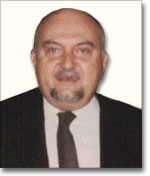|
|
|
|
 |
 |
 |
 Luigi
Cattaneo was born in Cura Carpignano (Pavia) on 10 February
1925 and graduated with honours in Medicine and Surgery from
the University of Pavia. His thesis was prepared at the Institute
of Normal Human Anatomy, where he became a voluntary assistant
during the same year. He then gradually worked his way up to
become a part-time assistant, an assistant on short-term contract
and finally, on 1 February 1956, a permanent assistant. During
those years, working under the authoritative guidance of Prof.
Antonio Pensa, the nervous system Study Centre's current director,
he distinguished himself for his interesting research into the
nervous connections of the olfactory bulb. This research won
him the coveted "Camillo Golgi" award from the Academy
of the Lincei. During the same period, he supervised anatomical
research carried out by some internal students, including Alessandro
Riva. Cattaneo then extended his research into nervous system
morphology to the mammalian cerebellum, of which he studied
the nuclei and nuclear connections during development. Lastly,
he became an adherent of the new histochemical approach to research,
which was taught and promoted in Pavia by Prof. Maffo Vialli.
This led him to make several interesting observations relating
to the medullar region of the adrenal gland and introduce new
methods for the selective demonstration of adrenaline and noradrenaline-producing
cells. Luigi
Cattaneo was born in Cura Carpignano (Pavia) on 10 February
1925 and graduated with honours in Medicine and Surgery from
the University of Pavia. His thesis was prepared at the Institute
of Normal Human Anatomy, where he became a voluntary assistant
during the same year. He then gradually worked his way up to
become a part-time assistant, an assistant on short-term contract
and finally, on 1 February 1956, a permanent assistant. During
those years, working under the authoritative guidance of Prof.
Antonio Pensa, the nervous system Study Centre's current director,
he distinguished himself for his interesting research into the
nervous connections of the olfactory bulb. This research won
him the coveted "Camillo Golgi" award from the Academy
of the Lincei. During the same period, he supervised anatomical
research carried out by some internal students, including Alessandro
Riva. Cattaneo then extended his research into nervous system
morphology to the mammalian cerebellum, of which he studied
the nuclei and nuclear connections during development. Lastly,
he became an adherent of the new histochemical approach to research,
which was taught and promoted in Pavia by Prof. Maffo Vialli.
This led him to make several interesting observations relating
to the medullar region of the adrenal gland and introduce new
methods for the selective demonstration of adrenaline and noradrenaline-producing
cells.
One of the main reasons the young Cattaneo's years in Pavia
were so intense in terms of research was because he had the
fortune to work alongside eminent lecturers and gifted researchers:
professors Bruno Zanobio, Francesco Loreti, Elio Borghese, Emilio
Casasco, Elio Guido Rondanelli and the sadly missed Professor
Valerio Monesi, who became a personal friend of Professor Cattaneo.
In 1956, he qualified to lecture in normal human anatomy and
then obtained a post teaching general Histology and Embryology
from 1960 to 1963; again at Pavia University.
On 1 January 1963, he received a contract to teach normal human
anatomy at the Cagliari University Faculty of Medicine and Surgery.
During the same year, he was appointed to the Chair of normal
human anatomy, and was called to his post by the Cagliari Medical
Faculty on 16 January 1964. His period in Cagliari was crowned
with such great personal success that Cattaneo became one of
the most revered and esteemed lecturers in Italy and young,
enthusiastic newly-graduated researchers were attracted to Cagliari
to join him: Alessandro Ruggeri, Alessandro Riva and Renato
Scandroglio.
The Institute of Anatomy thus became the pride of the Cagliari
Medical Faculty. Susini's wax models were also repaired personally
by Cattaneo and restored to their original splendour. Before
leaving Cagliari for Bologna, where he was called to lecture
in 1966-67, Luigi Cattaneo was responsible for preparing the
first edition of the Cagliari wax anatomical model catalogue.
Cattaneo soon made his mark in Bologna due to his captivating
personality and inexhaustible attributes: he was a learned,
enthusiastic and conscientious lecturer. New life was immediately
breathed into the Anatomy Department as assistants and new,
young researchers began to arrive, attracted by Cattaneo's modernised
teaching and research departments. He also set up an exquisite
Wax Museum of inestimable historical and artistic worth. While
in Bologna, Cattaneo set out to provide a guide to historical
changes in morphological approaches and content. He ended up
by revising the standard Medical text book of anatomy fully
to meet the changing needs of students.
This work, formerly named the "Pensa" after its previous
author and now known as the "Cattaneo", has met with
unanimous acclaim from generations of students in many Italian
universities, including Cagliari. Other major publications followed,
all greatly appreciated for the balance they achieve between
the old and the new ways of studying anatomy. The books are
also learned and well-written.
Cattaneo still had one goal left to achieve: an appointment
to the ancient Anatomy Department in Pavia where he began his
university career and where he hoped to spend the last uneventful
years of his academic life. The Medical Faculty in Pavia appointed
him unanimously in 1977, secure in the knowledge that they would
be regaining the well-loved and highly-regarded lecturer, the
learned man and the affectionate friend who had first graduated
there in 1950.
Cattaneo died in Pavia on 1 April 1992.
Note: much of this biography is
taken from the reminiscences of Professor Luigi Cattaneo read
out by Professor Alessandro Ruggeri at the 46th National convention
of the Italian Anatomy Society.
|
 |

|
|
| |
|
|
|